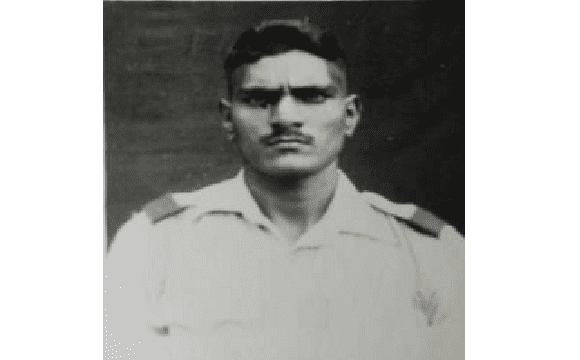
Service No : 4141584
Place of birth : Alwar, (Raj)
Service : Army
Last Rank : Sepoy
Unit : 13 Kumaon
Arm/Regt : The Kumaon Regiment
Operation : Indo-China War 1962
Martyrdom : November 18, 1962
Sepoy Sultan
Sepoy Sultan belonged to Kohrana village in Rajasthan’s Alwar district—an area deeply rooted in a tradition of valour and patriotic service. Motivated by a strong sense of duty towards the nation, he joined the 13 Kumaon Battalion, part of the illustrious Kumaon Regiment. Renowned as one of the Indian Army’s most historic and decorated infantry units, the Kumaon Regiment traces its origins back to the 18th century and is celebrated for its gallant performance in various military engagements.
Throughout his service, Sepoy Sultan embodied the values of discipline, commitment, and selfless service. He wore the uniform of the Kumaon Regiment with pride, honouring its rich legacy and upholding its high standards of conduct. By the year 1962, his battalion was stationed in Ambala, and soon after, it was mobilized to Jammu & Kashmir, reflecting the critical role his unit played in safeguarding the nation’s security during times of escalating tensions.
Battle of Rezang La (Indo-China War): 18 Nov 1962
In June 1962, Sepoy Sultan’s unit—the 13 Kumaon Battalion—was relocated from Ambala to Baramulla in Jammu & Kashmir under the command of Lt Col H.S. Dhingra. As tensions with China intensified later that year, the battalion was directed in September to mobilize to Leh at short notice. Once there, it came under the operational control of the 114th Infantry Brigade, commanded by Brigadier T.N. Raina, who would later ascend to become the Chief of Army Staff. Tasked with defending a vast 400-kilometer stretch of the Indo-China border—including the strategically crucial Chushul sector—the brigade comprised several distinguished units: 14 J&K Militia, 7 J&K Militia, 5 Jat, 1/8 Gorkha Rifles, and 13 Kumaon. Sepoy Sultan served in ‘C’ Company of 13 Kumaon, led by the legendary Major Shaitan Singh. As part of the brigade’s defensive strategy, ‘C’ Company was deployed at Rezang La. Meanwhile, ‘A’ Company, commanded by Maj G.N. Sinha, remained in reserve near the battalion headquarters at Chushul, and ‘B’ and ‘D’ Companies were stationed on Maggar Hill under Capt R.V. Jatar.
By 26 October 1962, Sepoy Sultan and his fellow soldiers had established fortified positions at Rezang La in preparation for an anticipated Chinese assault. ‘C’ Company was strategically positioned along the forward slopes of Rezang La to maximize defensive advantage. Platoon 7, under Jemadar Surja Ram, held the northern flank; Platoon 8, led by Jemadar Hari Ram, was tasked with securing the pass; and Platoon 9, under Jemadar Ram Chander, defended the central post alongside Company Headquarters. A supporting mortar section, led by Naik Ram Kumar Yadav, was positioned on the reverse slope. The Chinese launched their offensive on 18 November 1962, timed with a broader assault at Sela in NEFA. A two-pronged attack targeted both Gurung Hill and ‘C’ Company’s position at Rezang La—a critical stronghold guarding the approach to the Chushul airfield via Dungti.
The initial attack began at 2:00 AM, with Chinese troops advancing toward Platoon 8. Their movement was detected by the Listening Post, prompting Naik Hukam Chand to alert Jemadar Hari Ram. A counteroffensive was swiftly ordered, and as the enemy closed within 50 yards, Indian troops opened fire, effectively repelling the first wave. At 4:00 AM, a second assault emerged from the direction of Platoon 7. Jemadar Surja Ram and Naik Sahi Ram mounted a resolute defense using rifles, grenades, and light machine guns, successfully thwarting the attack. The Chinese forces pressed on with further waves at 4:55 AM, 6:00 AM, and 6:30 AM. Sepoy Sultan and his comrades fought with extraordinary tenacity, holding their positions despite being vastly outnumbered. By the sixth wave at 7:40 AM, the defenders were severely depleted. At 8:40 AM, the enemy deployed a 57 mm recoilless rifle in an exposed position along the ridge, signaling the start of the seventh and final assault at 9:00 AM.
Despite freezing temperatures, harsh terrain, and relentless bombardment, Sepoy Sultan and the soldiers of ‘C’ Company displayed unyielding courage and determination. During the brutal engagement, Sepoy Sultan was gravely wounded and ultimately made the supreme sacrifice. The battalion’s stand at Rezang La was pivotal—it not only delayed the Chinese advance but played a crucial role in safeguarding the Chushul airfield. Following the ceasefire, Rezang La became a disputed no-man’s land. The bodies of Sepoy Sultan and his fallen comrades lay buried beneath the snow until a local shepherd discovered them nearly three months later—a solemn reminder of their heroism and sacrifice.
Sepoy Sultan is survived by his wife, Smt Sarti Devi.

No Comments